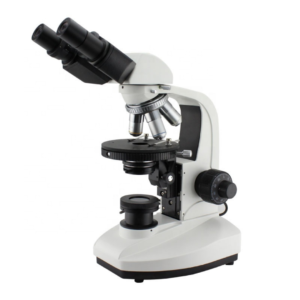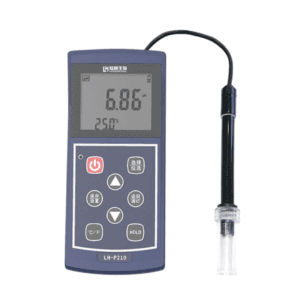$2,970.00
The Digital Inverted Microscope is equipped with advanced video and image processing and is best for precise laboratory cell analysis and live-cell imaging and recording.
The Digital Inverted Microscope comes with a total magnification between 100X and 400X. It is connected with a display screen or microscope camera to view the image of the specimen under observation. Also, it has a double-layer mechanical stage (with horizontal and vertical adjustable knobs) and three-sized petri dish trays, allowing you to observe different samples. With an inbuilt 2.0 USB interface, the microscope can transfer data at high speed.
ConductScience offers the Digital Inverted Microscope

Conduct Science is a premier manufacturer of research infrastructure, born from a mission to standardize the laboratory ecosystem. We combine industrial-grade precision with a scientist-led tech-transfer model, ensuring that every instrument we build solves a real-world experimental challenge. We replace "home-brew" setups with validated tools ranging from microsurgical suites to pathology systems. With a track record of >1,600 institutional partners and hundreds of citations, our equipment is engineered to minimize human error. We help you secure more data for less of your budget, delivering the reliability required for high-impact publication.

bool(false)


bool(false)
BLD-300 Trinocular inverted biological microscope is multifunctional microscope. It adopts excellent infinity optics system and provides eximious optical function. It is designed with good-looking shape and convenience operation. The long working distance condenser system is suitable for tissue observation in a high culture dish. The illuminate system to well consider spreading heat and safety. It also accords with man-machine engineering. The phase contrast device can be attached to the light path to perform transmitted phase contrast microscopic observation. This unit is suitable for the microscopic observation of cells, tissues and clear liquid tissues, and the dynamic microscopic observation of tissues cultured in a culture dish, and is applicable to scientific research institutions, colleges and universities, medical and health, inspection and quarantine agencies, agricultural, animal husbandry and dairy industries .
Features | Specification |
|---|---|
Head configuration | Trinocular |
Special Features | Inverted Phase contrasted |
Application | Research |
Brand | Suzhou Jingtong Instruments Co., Ltd. |
Features | Specification |
|---|---|
Total Magnification | 100X~400X (Standard) |
Eyepiece | WF10X - Ø22mm WF16X (Optional) - Ø11mm Eyepiece Diam - Ø30mm Parfocal Distance - Ø10mm |
Eyepiece tube | 45° inclined, interpupillary distance: 48~75mm |
BF Objective | 10X/0.25,20X/0.40, 40X/0.60 |
Phase Contrast Objective | 10X/0.25 (20X 40X optional) |
Nosepiece | Quadruple |
Focusing | Coaxial coarse/fine focusing with up stop, minimum division of the focusing: 2 um/ Effective distance: 11mm |
Stage | Double Layer Mechanical Stage (Size: 112 x 79), detachable stage, moving device |
Condenser | LWD condenser, W.D. 70mm, with phase-contrast device |
Petri Dish | 86mm x 129.5mm, suitable for circle dish Ø87.5mm 34mm x 77.5mm, suitable for circle dish Ø68.5mm 57mm x 82mm |
Phase Contrast System | Sliding phase contrast equipment, center adjustable |
Application | Research |
Light Source | 9W LED, with brightness control |
Filter | Frosted, Blue Filter |
Accessory | Hexagonal socket wrench (M4, M5) |
U3ISPM series is an ultra-high performance USB3.0 CMOS camera and it adopts ultra-high performance CMOS sensor as the image-picking device and USB3.0 is used as the data transfer interface.
U3ISPM series integrated with 12 bit Ultra-Fine Hardware Image Signal Processor Video Pipeline(Ultra-Fine HISP VP) for Demosaic, Adjustments, Automatic Exposition, Gain Adjustment, One Push White Balance, Chrominance Adjustment, Saturation Adjustment, Gamma Correction, Luminance Adjustment, Contrast Adjustment, Bayer and finally form RAW data for 8/12 bit output. This will move the heavier burden of the processing from the PC to the Ultra-Fine HISP VP and greatly accelerating the processing speed.
U3ISPM series comes with advanced video & image processing application ImageView; Providing Windows/ Linux/macOS/ Android multiple platform SDK (Native C/C++, C#/VB.NET, Python, Java, DirectShow, Twain, etc); The U3ISPM series can be widely used in bright field light environment and microscope image capture and analysis with higher frame rate.
Features | Specification |
|---|---|
Pixel(μm) | 1.4x1.4 |
Sensor & Size | 20M/AR2020(C) 1/1.8“(7.17x5.38) |
Exposure | 0.2ms~15s |
Spectral Range | 380-650nm (with IR-cut Filter) |
Recording System | Still Picture and Movie |
Cooling System* | Natural |
Operating System | Microsoft® Windows® XP / Vista / 7 / 8 /10 (32 & 64 bit) OSx(Mac OS X) Linux |
PC Requirements | CPU: Equal to Intel Core2 2.8GHz or Higher Memory:2GB or More USB Port:USB3..0 High-speed Port |
BLD-300 inverted biological microscope is multifunctional microscope. It adopts excellent infinity optics system and provides eximious optical function. It is designed with good-looking shape and convenience operation. The long working distance condenser system is suitable for tissue observation in a high culture dish.
The illuminate system to well consider spreading heat and safety. It also accords with man-machine engineering. The phase contrast device can be attached to the light path to perform transmitted phase contrast microscopic observation. This unit is suitable for the microscopic observation of cells, tissues and clear liquid tissues, and the dynamic microscopic observation of tissues cultured in a culture dish, and is applicable to scientific research institutions, colleges and universities, medical and health, inspection and quarantine agencies, agricultural, animal husbandry and dairy industries .
The Digital Inverted Microscope is equipped with advanced video and image processing and is best for precise laboratory cell analysis and live-cell imaging and recording. It can magnify various specimens with a total magnification between 100X to 400X.
The construction of this microscope is the reverse of the normal microscope, where its components are placed in inverted order. The condenser lens points downwards towards the specimen stage, while the turret and the objective face upwards from below the stage. However, its working principle is similar to upright microscopes. Both focus light rays on the specimen and form an image viewed by the objective lenses. The condenser lens focuses light on the specimen stage placed on a larger stage, and the objective (below the stage) collects the light from the condenser, magnifies images, and sends it to the ocular lens. This ocular lens reflects the light through a mirror, and cells can be viewed easily through the bottom part of the cell culture apparatus.
The digital inverted microscope is useful for observing specimens under more natural conditions, such as a tissue culture flask or Petri dish since samples don’t have to be prepared on glass slides.
The Digital Inverted Microscope comes with a total magnification between 100X and 400X. It is connected with a display screen or microscope camera to view the image of the specimen under observation. Also, it has a double-layer mechanical stage (with horizontal and vertical adjustable knobs) and three-sized petri dish trays (86mm × 129.5mm, 34mm × 77.5mm, and 57mm × 82mm in size), allowing you to observe different samples. With an inbuilt 2.0 USB interface, the microscope can transfer data at high speed.
The LWD infinity plan monochromatic objective and LWD infinity plan phase contrast objective are perfect for both black and white and colored image viewing. The 22mm WF10X (Optional 11mm WF16X) eyepiece is (30mm diam and 10mm parfocal distance) fitted in a 45° inclined eyepiece tube with an interpapillary distance of 48~75mm. The 0.35M to 14M hardware resolution ideally presents fine details in the sample.
With the 9W LED light source, you can also control the brightness depending upon how much is required for sample observation.
Place the glass container containing the specimen on the center of the microscope’s stage. Turn the 10X objective. Adjust the light control knob to get proper illumination. Adjust the interpapillary distance through the eyepieces. Also, adjust the position of condenser light control and diaphragm aperture diaphragm to get satisfactory illumination. To obtain the sharp image from the specimen, adjust the fine/coarse focus. Use the vertical thumbscrew if the lamp needs to be adjusted and the horizontal thumbscrew to adjust the centering of the light. Connect the camera to the eyepiece tube. Connect the camera to a laptop or computer to view the specimen on the screen.
The Digital Inverted Microscope is used for various research, including fungal cultural diagnoses such as Phytophthora spp in cultures, observation of nematodes (Vermiform nematodes), and in the observation of living microbial cells in the tissue cultures placed in Petri dishes and flasks. Some other applications of the digital inverted microscopes include;
Detection of Early Growth of Mycobacterium tuberculosis in MODS Culture
The MODS is a rapid, sensitive, and inexpensive method used to detect the early growth of Mycobacterium tuberculosis (MTB). The detection of tuberculosis and multi-drug resistant tuberculosis requires an inverted light microscope as it needs an image in the MODS culture to be viewed from below. The visualization of MTB is done in liquid media using 24-well cultured plates. The microscope visualizes the characteristics of the growth of MTB and presents rapid and accurate detection of the sample. Using the digital inverted microscope in the detection overcomes two problems put forth by the conventional upright light microscope. Firstly, it facilitates the condensation on the plate lid, and cultural medium obstruction and interference get cleared when viewing from the bottom (that gets obscured when viewing from above). Secondly, the objective-bottom (where the MTB colonies aggregate) is greater than the upright light microscope and thus helps in clear magnification of the image.
Live Cell Imaging
The digital inverted light microscope is used in live-cell imaging using an aluminum cell culture incubator on its stage. The incubator effectively maintains the temperature at 37°C and provides focal stability of an image for 20-25 min after equilibrium. Rines, Thomann, Dorn, Goodwin, and Sorger (2011) performed live-cell imaging of yeast and studied dynamic cellular processes like cell division, growth, and morphogenesis. Hickey, Swift, Roca, and Read (2004) studied live-cell imaging of fungal hyphae and analyzed its molecular dynamics and organelle at high spatial resolutions at a single-cell level.
Cell observation through a digital inverted microscope has greatly widened cellular and molecular biology knowledge. It comes with a wide stage to allow the convenient study of specimens in glass tubes, Petri plates, or flasks and thus is ideal for studying live cells from the bottom of the cell culture apparatus. It is used to study cells in large amounts of the medium. This also allows the user to study cells in original vessels compared to upright microscopes that require the samples to be prepared on glass slides.
Another benefit is that it keeps the specimen uncontaminated by preventing contact with the objective lens. Therefore, the sterility of the sample is maintained. The samples can also be observed over a longer period. Furthermore, the need for staining the specimen is eliminated as it creates different shades of brightness to enhance the image viewing experience.
These microscopes require high optical quality as the image is viewed through a thick Petri plate compared to an upright light microscope. Another limitation is its high cost.
| Weight | 3 lbs |
|---|---|
| Dimensions | 45 × 47 × 55 cm |
| Brand | ConductScience |
| distance-adjustment-range | |
| eyepiece-magnification | |
| total-magnification |
You must be logged in to post a review.
There are no questions yet. Be the first to ask a question about this product.
Reviews
There are no reviews yet.